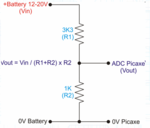ozcanay
Newbie level 6

Hi,
I am building an ohmMeter for my course project. I am trying to make use of voltage divider principle.

Divider is given above. I am using STM32F429(12 bit ADC ->4096 max) and the voltage source is 3.3V . I am using 3.3k ohm(R1) pull up resistor. When I measure 3.3k ohm resistor I read the value of 2048 as expected. But when I try to measure for example 10k ohm, I am reading value that is so different from the expected one.
I have searched for the reason on the internet and came across this : measuring voltage across unknown resistor what is hyperbolically dependent on the measured resistance, so actual precision varies greatly over the range of values of unknown resistor.
My question is why it is hyperbolically dependent on the known resistor? Does it have something to do with ADC input resistance?
Thanks in advance.
I am building an ohmMeter for my course project. I am trying to make use of voltage divider principle.

Divider is given above. I am using STM32F429(12 bit ADC ->4096 max) and the voltage source is 3.3V . I am using 3.3k ohm(R1) pull up resistor. When I measure 3.3k ohm resistor I read the value of 2048 as expected. But when I try to measure for example 10k ohm, I am reading value that is so different from the expected one.
I have searched for the reason on the internet and came across this : measuring voltage across unknown resistor what is hyperbolically dependent on the measured resistance, so actual precision varies greatly over the range of values of unknown resistor.
My question is why it is hyperbolically dependent on the known resistor? Does it have something to do with ADC input resistance?
Thanks in advance.


